The Purity of Kanji, the Solace of Japan
Ah, where to start? What a whirlwind trip I took to Japan! In a little more than a week, I hung out (usually for long periods) with 14 people, including four proofreaders, the main JOK web designer, and dictionary guru Jack Halpern.
Aside from all the ways in which I enjoyed these get-togethers, as well as the immersion in a kanji-rich world, the highlight of the trip had to be the island of Shodoshima in the Seto Inland Sea. Antoine de Saint-Exupery wrote about teaching people to long for the sea; Donald Richie made me long for the Inland Sea years ago, and this desire has never faded. More recently, writing about Shodoshima (小豆島, しょうどしま) in essay 1640 on 豆 (まめ: bean) made me eager to visit the place.
On Shodoshima we saw scads of wild monkeys and even fist-bumped one of them after a monkey show. Strangely, while inviting us to take a picture with the star performer, the monkey handler addressed my husband and me as 外人様 (がいじんさま), linking the rude 外人 (がいじん: "outside person," foreigner) with -様 (-さま), the bit that follows people's names in ultra-polite sentences!

Photo Credit: Eve Kushner
This monkey was an incredible acrobat! The characters on the back wall are 銚子渓 (ちょうしけい), the area on the island where the monkey park is located. The first kanji is non-Joyo and means "saké bottle." The middle one is "child." The last means "mountain stream; valley."
We also visited the set of the tearjerking classic movie Twenty-Four Eyes (二十四の瞳, にじゅうしのひとみ), and simply hearing the music again on the site filled me with the strangest nostalgia for ... I'm not sure what!
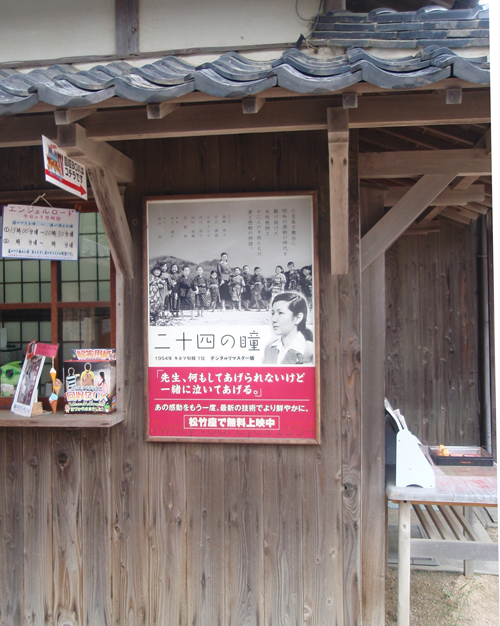
Photo Credit: Eve Kushner
The poster for the original 1954 movie (which was remade in 1987).
I hope to write much more about Shodoshima in blogs to come. But I have to say that my mind is not on Japan right now.
The day after we returned to California, I headed to the office I've rented for 10 years in a Victorian house that offers boundless charm. I hoped I'd be able to work hard, even though I drooped with jet lag. Because my industrious proofreaders had all sent me work while I was gone, I knew I was way behind and felt certain that the week would be challenging. Little did I know.
I found the lobby in complete disarray with all the chairs overturned and wide streaks of mud on the carpet. The mud continued up the stairs. And then my room ... Much emptier than when I left. All electronics gone: a computer, a two-week-old monitor, a keyboard, a mouse, a printer, a modem, two headsets, two tape recorders, a phone, a mini-refrigerator, an electric kettle, and more. Large blank walls greeted me; several pieces of art had left the place, including works from Japan, Tahiti, Peru, and Oregon. Whatever I had bought myself for my last birthday, including elephant bookends made of stone, had vanished. The valuable rug from my parents' trip to Turkey was no longer there. Neither were the dogs' water dish and treat jar (why???), though I found all the dog treats strewn in the closet. They had become stale. Small containers holding paper clips and binder clips had disappeared. A friend had bought one with inlaid ivory for me in Egypt, and a lovely round container made of smooth, rich wood had come from another friend. Paper clips and binder clips lay scattered on several surfaces, as did Post-It notes, almost like blossoms, but not quite.
I will say quite gratefully that the thieves left behind every Japanese book in my collection, though I'll need to replace the magnifying glass that enables me to read the dictionary Kanjigen. Perhaps it's a blessing that Japanese has such a high barrier to entry.
Also, I have all the data from my computer backed up elsewhere. This is crucial and priceless. I can't begin to imagine having lost my kanji photos.
Other losses have been more nebulous and didn't make it into the police officer's list of what disappeared or the approximate value. For a few days after my grim discovery, I couldn't feel the joy o' life in any significant way. And this event has shaken my faith in my own judgment.
The day before I headed to Japan, two decent-looking young men came around, saying they wanted to rent some space on the property. (They mentioned the quote the landlord had given and said they would meet him again the next day.) They told me they were architects, specializing in bamboo construction and green approaches. A topic close to my own heart! I had published scads of articles about environmentally friendly architecture—as I bet they well knew. And we talked and talked about architecture ... or did I do most of the talking? One of them ended up telling me his birthday—lo and behold, the same as mine. They wondered if they could come in and look around the building. Ah, yes, of course. My office, too, just to round out the picture. Oh, they very much liked what I had done with it.
I do not like what they subsequently did with it.
The landlord, by the way, said he had never heard of them.
I'm one of those who likes to believe I can control my life, if only I'm sufficiently organized and disciplined. Ordinarily this works out for me pretty well. And when it doesn't? It's hard to make sense of the massive disappointments that inevitably come.
Perhaps it's fitting that the essay I'm publishing today, essay 1898 on 柳 (やなぎ: willow), contains the following expression:
柳に風 (やなぎにかぜ: handling things without making waves; taking (something) in stride; following the path of least resistance) willow + wind
As people respond to life’s vicissitudes, they aspire to be like a willow in a storm.
I'm trying to get there in terms of the robbery, and I think I can. However, I don't think I'll ever understand this particular "storm." It's one thing (and an utterly reprehensible thing) to steal from a total stranger. But how can you rob someone after getting to know them? How can you violate their trust after they've kindly (and stupidly) allowed you into their personal space?
In Tokyo last weekend, at a restaurant called Squid Center, a server carried a wriggling squid to our table for an introduction, then brought him back in pieces a few minutes later. I refused to touch the dish. I had looked into his eyes.
I know vegetarians could pounce on me right about now for not having that attitude all the time. Believe me, if I liked vegetables more, I'd eat things only from the plant world. I'm a very guilty omnivore. I'm guilt-ridden in general, worrying over nothing, over everything.
And the thieves? How can a human being have no conscience? What has gone utterly wrong in the emotional wiring of those burglars? I'll never grasp this, and I really don't want to think too much about something so dirty.
Instead, I'm trying to dig down to a pure, unaffected place in myself, the place that can never be stained (unlike the carpets in the office building).
As always, I find that my love of kanji is the purest thing I know, coming out of the childlike sense of wonder that we naturally have before things interfere.
In Japan, as usual, I lost control of my "trigger finger" and took about 1,400 pictures, mostly of kanji. In an odd way, these photos represent another type of setback, in that I kept finding kanji that I'd already published essays about, and I felt determined to add them to the PDFs. It's crazy to go backward and to return to what I've completed, instead of focusing on the nearly 2,000 unwritten essays that need attention. But I felt exuberant whenever I spotted one of "my" kanji, such as 肩 (1513: shoulder), 竜 (1899: dragon), 臼 (1987: mortar), 亀 (1985: turtle), and so many more. I felt as if they were my children and were up on a stage, starring in a play!
I saw 匠 (1388: craftsperson) everywhere. As I've written in JOK Notebook and in essay 1388, marketers have coopted the 匠 kanji, probably because it conveys a sense of mastery, which is a quality every business would like to claim that it has. Indeed, as I saw this kanji in sign after sign, it became kind of an inside joke for me. I almost wanted to see a humble sign deeming someone's business second-best (or apprentice-level only!).
As I investigate kanji here in Berkeley, whatever I learn about Japan seems unreal on some level. Going there makes it all come to life. I can't tell you how many times I saw combinations of pine trees, bamboo, and plums, as on this dish in an Osaka sushi restaurant:
I had just blogged about this theme, and there it was—in a dish, in the shapes of candy that a friend gave me, in a 松竹梅 apron that I saw a server wearing... So many things clicked into place for me on that trip!
I'll close here with a few images that brought me solace this week as I reviewed my photos. I hope you enjoy them!
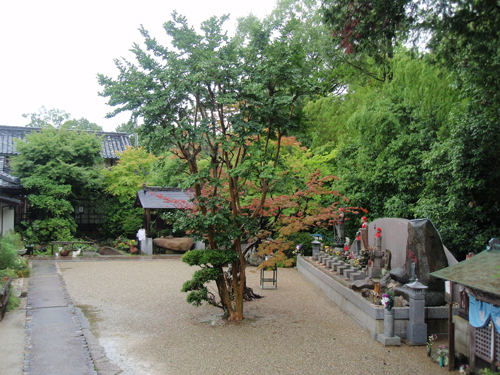
Photo Credit: Eve Kushner
Konshin-ji Temple in the city of Sanda, Hyogo Prefecture. This complex dates back to the eighth century!
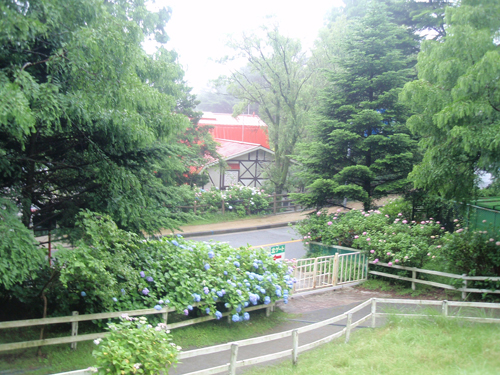
Photo Credit: Eve Kushner
Lovely plantings at Rokko Farm.
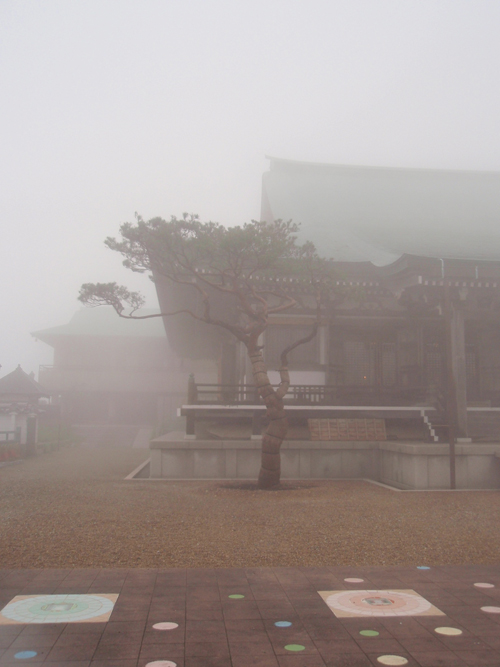
Photo Credit: Eve Kushner
Mayasan Tenjoj-ji Temple, which an Indian monk first built in 646 CE! This temple is also in the Rokko Mountains in Hyogo Prefecture. Shrouded in fog, the temple certainly had a mystical feeling!

Photo Credit: Eve Kushner
Peter Rabbit popped up everywhere at Rokko Garden Terrace, which had a beautiful cafe and a terrific view of Kobe.
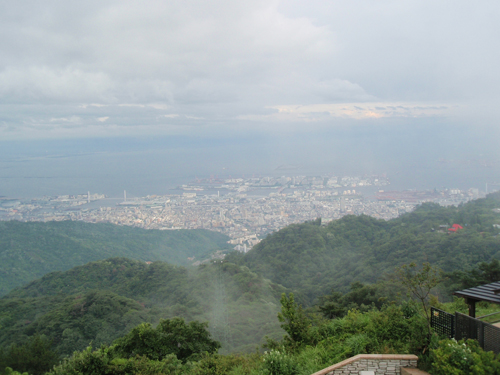
Photo Credit: Eve Kushner
Here's the view of Kobe from Rokko Garden Terrace.
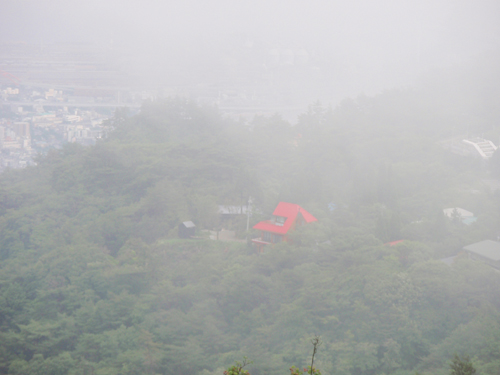
Photo Credit: Eve Kushner
The fog erased the vista in a matter of minutes, leaving behind this brilliantly red roof.
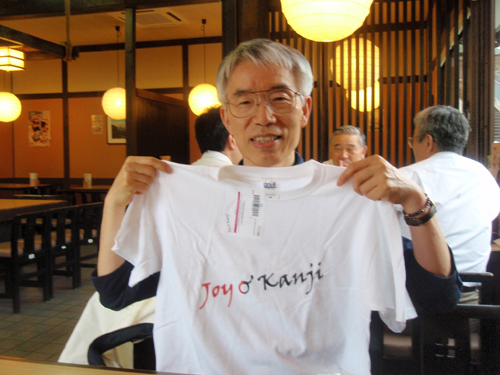
Photo Credit: Eve Kushner
Proofreader and tour guide extraordinaire Hideo Suzuki was thrilled to receive a Joy o' Kanji T-shirt! (The red stripe at the top is on an easily removed sticker that contains care instructions.)
Now it's time to return to a strict focus on kanji. In the next month it may be difficult to keep to my prior publication schedule because I've lost countless hours to this office disaster and will continue to do so. But I'll try my best not to let the thieves take my plans away from me, too. The show must go on, as they say!
For now, I hope you enjoy essay 1898 on willows, which features gorgeous photos by several talented photographers, as well as lots of insights into the roles of willows in Japan.
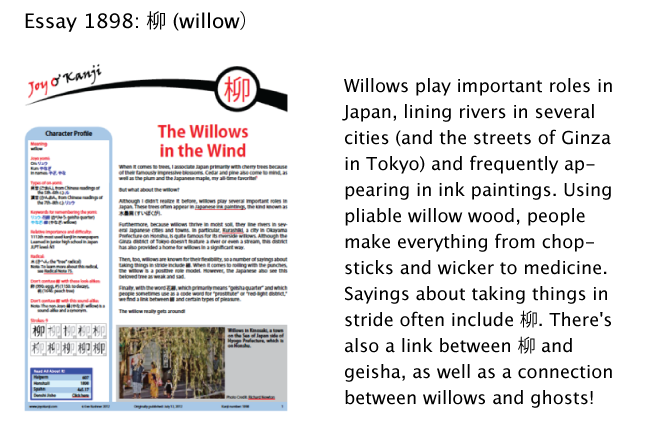
Have a great weekend! Stay safe. And if someone claims to be an architect, don't believe him!

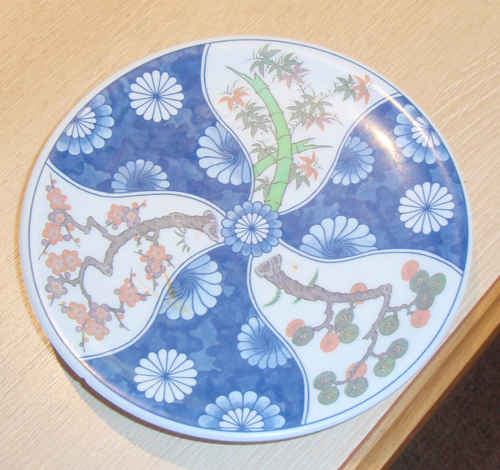

Comments